英语资格证面试语音课环节解读 二
- 格式:doc
- 大小:471.00 KB
- 文档页数:3
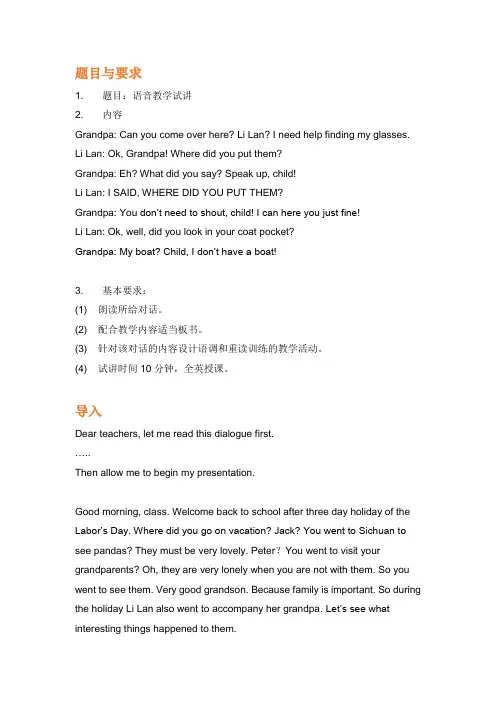
题目与要求1. 题目:语音教学试讲2. 内容Grandpa: Can you come over here? Li Lan? I need help finding my glasses. Li Lan: Ok, Grandpa! Where did you put them?Grandpa: Eh? What did you say? Speak up, child!Li Lan: I SAID, WHERE DID YOU PUT THEM?Grandpa: You don’t need to shout, child! I can here you just fine!Li Lan: Ok, well, did you look in your coat pocket?Grandpa: My boat? Child, I don’t have a boat!3. 基本要求:(1) 朗读所给对话。
(2) 配合教学内容适当板书。
(3) 针对该对话的内容设计语调和重读训练的教学活动。
(4) 试讲时间10分钟,全英授课。
导入Dear teachers, let me read this dialogue first.…..Then allow me to begin my presentation.Good morning, class. Welcome back to school after three day holiday of the Labor’s Day. Where did you go on vacation? Jack? You went to Sichuan to see pandas? They must be very lovely. Peter?You went to visit your grandparents? Oh, they are very lonely when you are not with them. So you went to see them. Very good grandson. Because family is important. So during the holiday Li Lan also went to accompany her grandpa. Let’s see what interesting things happened to them.新授Now listen to the dialogue and tell me.//It’s over. What happened to them? Iris? Iris said grandpa can’t find his glasses and asked Li Lan to help him. Is she right? Yes, nicely done! Sit down please. And did they find it in the end? No? Why? Oliver. Because grandpa couldn’t hear Li Lan clearly and misunderstood her question. Is he right? Yes, excellent!You all got the meaning of this dialogue clearly. Let’s pay attention to the tone they speak. O k, let’s listen again.//Have you notice the tone of all these sentences? Yes? So who can tell me which sentences are the rising tone? Frank. Frank said they are “Can you come over here?” “Did you look in your coat pocket?” and “My boat?” Yes, quite right. But do you know why? No? You just listen that they said it in that way. That’s ok. Sit down please. Class. Let’s all look at the material together. Can you find if there is a similarity of the first two sentences? Yes? They are all questions? Indeed. But what kind of question? Oh, general questions. Yes. So can you conclude the rule now? Frank, try again. You said if the sentence is a general question, it should be spoken in a rising tone. Excellent. As for the last one. There is only a noun phrase, so we also use rising tone. clear?Ok, then next question. Which sentences are the falling tone? Yes. Of course the rest of the dialogue. But can you find what kinds of sentences are they? Such as “what did you say?” Tina. It is a specific question? Yes. Good. Then sentence like “I need help finding my glasses.” They are…yes, we call them declarative sentence. Sit down please. Your have a solid grammar foundation.While listening, do you find that some words are stressed and others are not? Yes? But what kinds of words can be stressed and what kinds are not? Youcan’t say it exactly? Ok, let’s listen again and this time, pay attention to what kinds of words did they stress.The tape is over. Did you find it? Cindy, you said you find that words like “come, need, help, finding, glasses. Grandpa..fine..” are stressed. Good, you listened very carefully. Can you find what the property are they? They are nouns, and? Yes, nouns, verbs, adjectives. Right. sit down please. Apart from these three kinds of word s, adverbials also needs to be stressed. But we don’t have an adverbial in the dialogue. But still remember that. Then almost the rest words are not stressed. Ok sit down. Oh I see Sara put up her hand. Sara please. You ask why the sentence “I SAID, WHERE DID YOU PUT THEM?” are all stressed? Good, you listened very carefully. The rules we conclude just now are general rules. But when someone really wants to stress on something he intends to let others pay attention. These words can also be stressed. Because grandpa can’t hear clearly. Li Lan stressed every word in a loud voice. Clear about all the rules now?练习与巩固Ok, now let’s read after the tape and pay attention to the tone and stress. // Now work with your deskmate, have a dialogue and correct each others pronunciation, tone and stress. Five minutes for you to practice and then I would like some pairs to come to the front to have a role play.//Time is up! Which pairs want to show us? David and Rita please. So David played as grandpa and Rita as Li Lan. You can start! //They finished. Is there anything they should pay attention? Betty? You said the sentence “Where did you put them?” should be falling tone. Yes. Good sit down please. But they performed very well. They are really like grandpa and granddaughter, right? Excellent performance. Thank you, go back to your seat.总结与作业Ok, class. What we have learned today. Who can help me to summarize. Look at the blackboard. Elaine, please. You said that we have learned the tone and stress. So when do we use rising tone? Yes, when the sentence is a general question. And when do we use falling tone? When the sentence is declarative or specific question. Well done. Sit down please. Let’s leave the other rules to Woody. Woody, so when do we stress? Yes, when the words are nouns, verbs, adjectives and adverbials. Anything else? Yes, we can also emphasize on any word we want the have a stress on them. Brilliant! I can see that you all master the rules. And during the practicing I see that you have become more confident when you read.After class, you can find any dialogue you are interested in and read it out with tone and stress. Ok? Good. Let’s call it a day. See you next time.That’s all for my presentation. Thank you.。
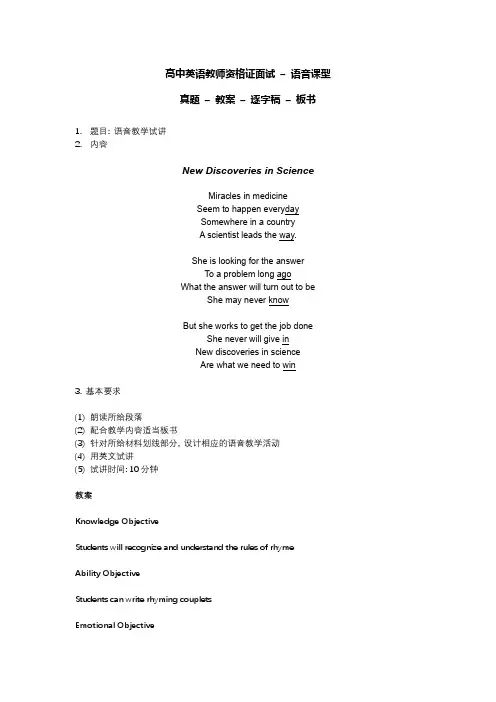
高中英语教师资格证面试–语音课型真题–教案–逐字稿–板书1.题目: 语音教学试讲2.内容New Discoveries in ScienceMiracles in medicineSeem to happen everydaySomewhere in a countryA scientist leads the way.She is looking for the answerTo a problem long agoWhat the answer will turn out to beShe may never knowBut she works to get the job doneShe never will give inNew discoveries in scienceAre what we need to win3. 基本要求(1)朗读所给段落(2)配合教学内容适当板书(3)针对所给材料划线部分, 设计相应的语音教学活动(4)用英文试讲(5)试讲时间: 10分钟教案Knowledge ObjectiveStudents will recognize and understand the rules of rhymeAbility ObjectiveStudents can write rhyming coupletsEmotional ObjectiveStudents get interested in appreciating English poemsTeaching Key and Difficult Points:Key Point – Students get to understand the rules of rhymeDifficult Point – Students are able to write rhyming coupletsTeaching Method3P (Presentation – Practice – Production)Teaching ProcedureLead-inHave a quick review on rules of stress with studentsPresentation1.The teacher reads the poem and students try to get the main idea of the poem2.The teacher reads the poem again and have students recognize something in commonof the underlined words3.The teacher explains the rules of rhymePractice1.Students read the poem to their elbow partners and then the teacher invite some of themto read the poem in front of the whole class2.The teacher reads some rhyming couplets and asks students which words are rhymed Presentation1.Students work in groups and try to write rhyming couplets2.The teacher invites students to read their rhyming coupletsSummaryThe teacher helps students to summarize what they have learned in classHomeworkStudents write a short poem with rhyming couplets and hand it in tomorrow逐字稿(Greeting)Good morning, boys and girls. How are you doing today? Great? Glad to hear that. If you are ready, let’s begin our class.(Lead-in)Last week, we studied rules of stress. So, let’s have a quick review first. Michael, do we need to place stress on a one-syllable word? (Michael…) Exactly, Michael, thank you. We always place stress on a one-syllable word. Then Nina, what about a two-syllable word?(Nina…) Good job. Thank you, Nina. The first syllable is usually stressed when it comes to a two-syllable word, like “custom” and “many”. Jenny, what words are often stressed in a sentence? (Jenny…) Thank you, Jenny, you’re right. Content words such as verbs, nouns, adjectives are usually stressed. Leo, what words are not stressed in a sentence?(Leo…) Thank you, Leo. Yes, we don’t place stress on structure words like articles, conjunctions and prepositions. Excellent. You guys did a fantastic job last week.(Presentation)Today we are still going to learn some rules about pronunciation. Now I’ll read you a poem. After that, I would like you to tell me what this poem is about. Now please listen to the poem.Well, Cynthia, what is this poem about? (Cynthia…). Exactly, Cynthia, thank you. Of course, this poem is about new discoveries in science. Now everyone please open your book and turn to page five. I’ll read it again and this time I would like you guys to pay special attention to the underlined words. Then you can have a discussion with your elbow partner on what things in common these words have in terms of pronunciation. Now, I’ll read the pome again. Please listen carefully. (The teacher read the poem.) Well, you can start discussing with your elbow partner. Here we go.T ime’s up. Alex, do you find something in common among the underlined words? (Alex…). Thank you, Alex. You’re quite perceptive. They have same sounds in the final syllables which usually include a vowel sound, like “day” and “way”, “ago” and “know”, “in” and “win”. People refer to this phenomenon as rhyme in English. As to pairs of lines that end in words that rhyme, people refer to them as rhyming couplets.(Practice)N ow, I’ll give you 3 minutes to read the poem by yourselves. Then I’ll invite some of you to read the poem. Let’s begin.Time’s up. Billy, can you read the poem for us?(Billy…) Great job, Billy. Thank you.Now, I’ll read you some rhyming couplets. After that, I would like you to tell me the rhyming words in them. Here we go.Terry, what are the rhyming words in the couplet I just read? (Terry…) Thank you, Terry. Well done. “Cat” and “Hat” are the rhyming words.(Presentation)N ow, It’s time you write some rhyming couplets. You need to work with your elbow partner and write two rhyming couplets. You have 5 minutes. Let’s begin.T ime’s up. Amy, could you share your couplets with us?(Amy…) Thank you, Amy. Fantastic job there.(Summary)N ow let’s have a quick recap. Sunny, can tell me what is rhyme? (Sunny…). Thank you, Sunny. And Derek, what is a rhyming couplet? (Derek…). Exactly. Thank you, Derek.(Homework)Let’s call it a day. As for the homework, you need to write a short poem with rhyming couplets and hand it in tomorrow. Thank you for your time, boys and girls. Have a good day.板书RhymeDay – Way /ei/Ago – Know /nəʊ/In – Win /in/。
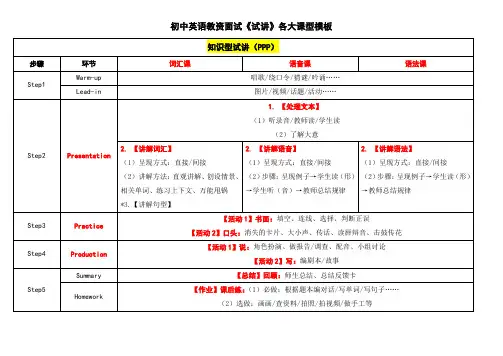
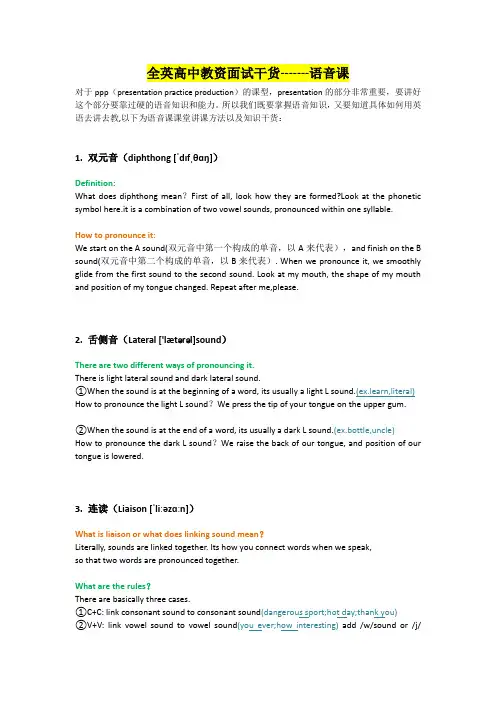
全英高中教资面试干货-------语音课对于ppp(presentation practice production)的课型,presentation的部分非常重要,要讲好这个部分要靠过硬的语音知识和能力。
所以我们既要掌握语音知识,又要知道具体如何用英语去讲去教,以下为语音课课堂讲课方法以及知识干货:1.双元音(diphthong [ˈdɪfˌθɑŋ])Definition:What does diphthong mean?First of all, look how they are formed?Look at the phonetic symbol here.it is a combination of two vowel sounds, pronounced within one syllable.How to pronounce it:We start on the A sound(双元音中第一个构成的单音,以A来代表),and finish on the B sound(双元音中第二个构成的单音,以B来代表). When we pronounce it, we smoothly glide from the first sound to the second sound. Look at my mouth, the shape of my mouth and position of my tongue changed. Repeat after me,please.2.舌侧音(Lateral ['lætərəl]sound)There are two different ways of pronouncing it.There is light lateral sound and dark lateral sound.①When the sound is at the beginning of a word, its usually a light L sound.(ex.learn,literal) How to pronounce the light L sound?We press the tip of your tongue on the upper gum.②When the sound is at the end of a word, its usually a dark L sound.(ex.bottle,uncle)How to pronounce the dark L sound?We raise the back of our tongue, and position of our tongue is lowered.3.连读(Liaison [ˈliːəzɑːn])What is liaison or what does linking sound mean?Literally, sounds are linked together. Its how you connect words when we speak,so that two words are pronounced together.What are the rules?There are basically three cases.①C+C: link consonant sound to consonant sound(dangerous sport;hot day;thank you)②V+V: link vowel sound to vowel sound(you ever;how interesting)add /w/sound or /j/sound or /r/ sound when we try to connect two vowel sounds.③C+V: link consonant sound to vowel sound(take up,speak up)4.句子内单词的重读(stress)Concept:Some words are emphasized, some of them are not. This is called stress.We pronounce some words louder, longer and at a higher-pitched note when we stress. What are the rules:①We stress content words like adverbs, adjectives, nouns, verbs etc. They are the words that convey meanings.②We do not stress function words like prepositions, linking words, articles, pronouns etc. They are the words that do not convey meanings but perform grammatical functions.③If necessary, we can deliberately stress whatever words we want to make an emphasis.5.单词内音节的重读(stress)When it comes to the word made of two syllables, there are two cases.if its a noun like center, we stress the first syllable /cen/if its a verb like admit, we stress the second syllable /mit/For compound words, there are at least three different kinds of conditions.①compound words consist of two nouns like bookshelfwe stress the first part, book②compound words consist of adjective and past participle like middle-agedwe stress the second part,aged③compound words consist of preposition and verb like outshinewe stress the second part, shineFor words with suffix, there are at least two ways of stressing.We can stress the syllable before the suffix (economic)We can also stress the third syllable from the last syllable (biology)Where we stress depends on different suffix.6.停顿(pause)Concept:There are temporary stops in our speech. We stop for an instant or lengthen the last soundfor an instant to catch a breath or help people organize the sense groups and grasp the message.Rules of pause :We divide the sentence into different sense groups and make a short pause between sense groups but never during a sense group.(Sense groups are closely connected in terms of meaning and grammar. She is /my favorite student /in class.)Never should we pause at any word within a sense group, because in that way, sense group is broken and cannot form a complete same meaning any more.(bad example: If i was young,i would make a /great effort to get into a prestigious college.7.语调(intonation )Concept:There are rises and falls in our speech. Our voice goes up and down so that our speech is cadenced. This is what we call intonation.Rules of intonation :Tell me what sentences are in the rising tone and what sentences are in the falling tone? Then try to classify them into different groups. We will find: ①for general questions, we use rising tone ②for special questions introduced by wh-word(who,what,when,where)andstatements, we use falling tone③for alternative questions ,we first use rising tone and then falling tone +④for tag questions, we first use falling tone and then rising tone +sense group 1 sensegroup 2sense group 3wrong pause Example sentence: alternative question: Which kind of beverage would you like, sparkling water of coffee ? tag question :You wouldn ’t leave today ,would you ?8.失去爆破(loss of plosive)Concept:When a word ends with one of the plosive sounds like /p/, /b/ ,/t/ ,/d/, /k/, /g/(plosive consonants),no air is followed by a word beginning with one of those plosive sounds or /m/, /n/.Rules:There is a stop at the end of the first consonant. So, we cannot really hear the plosive sound. We mouth it,which means we move the lips without making a sound.Examples: big bang, sit down, sad time9.音的同化(assimilation)Concept:Assimilation is a phonological process in which two sounds that are different become more alike.Rules:①progressive assimilationthe preceding sound is influencing the following soundwhat’s (s z)②regressive assimilationnewspaper( z s)the following sound is influencing the preceding sound③double assimilation(/wu:d u/ /wu:dʒu/)would。
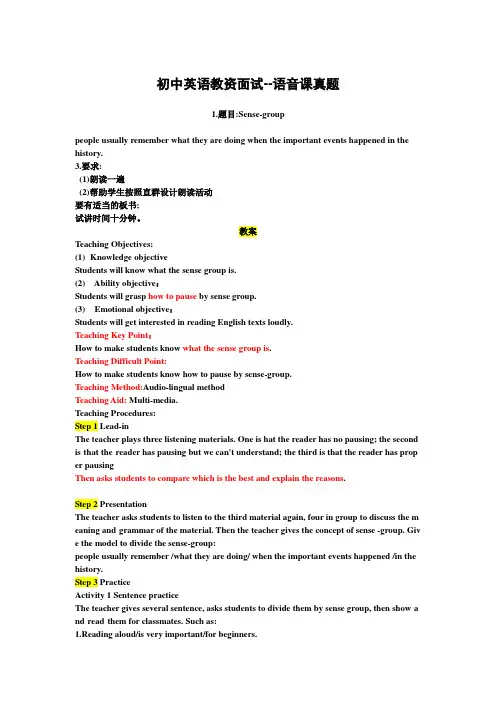
初中英语教资面试--语音课真题1.题目:Sense-grouppeople usually remember what they are doing when the important events happened in the history.3.要求:(1)朗读一遍(2)帮助学生按照直群设计朗读活动要有适当的板书;试讲时间十分钟。
教案Teaching Objectives:(1) Knowledge objectiveStudents will know what the sense group is.(2) Ability objective:Students will grasp how to pause by sense group.(3) Emotional objective:Students will get interested in reading English texts loudly.Teaching Key Point:How to make students know what the sense group is.Teaching Difficult Point:How to make students know how to pause by sense-group.Teaching Method:Audio-lingual methodTeaching Aid: Multi-media.Teaching Procedures:Step 1 Lead-inThe teacher plays three listening materials. One is hat the reader has no pausing; the second is that the reader has pausing but we can't understand; the third is that the reader has prop er pausingThen asks students to compare which is the best and explain the reasons.Step 2 PresentationThe teacher asks students to listen to the third material again, four in group to discuss the m eaning and grammar of the material. Then the teacher gives the concept of sense -group. Giv e the model to divide the sense-group:people usually remember /what they are doing/ when the important events happened /in the history.Step 3 PracticeActivity 1 Sentence practiceThe teacher gives several sentence, asks students to divide them by sense group, then show a nd read them for classmates. Such as:1.Reading aloud/is very important/for beginners.2 Early to bed/and early to rise/makes a man/healthy, happy, and wiseActivity 2 Passage practiceStudents choose passages that they are interested in to read for classmates in competition.Step 4 Summary and HomeworkSummary: Ask students to conclude what they have learned in the class.Homework; Ask students to listen to a passage of VOA to consolidate how to pause by sense-group after class.Blackboard Design:板书people usually remember /what they are doing/ when the important events happened/ in the history.语音课逐字稿Good morning,everyone, i am Miss XX. it’s my honor to participate this interview, now i will begin my class.Good morning boys and girls, i am Miss X, today we will learn english together!How are you today? Ok ,good!In today’s phonetic class we will learn about sense group! Now ,i will read a sentence twice, and tell me which time is easier to understand?The First time:people usually remember what they are doing when the important events happened in the historyThe second time:people usually remember /what they are doing/ when the important events happened /in the history (read with pause)Ok, in which time do you understand the sentence better?Most of you said the second time,why?Because i make a pause between words,right?So what is sense group?According to the meanings and grammatical structure, a sentence can be divided into several small pieces,in this sentence, we divide it into 4parts, two clauses leaded by what and when,so we should pause before these two clauses.each small section is called a sense-group.Sense-group can be a word, a phrase, also can be some short-sentences or the clause in a complex sentence. Do you understand?Now i will give you two sentences, read them twice with your partner, make a pause between words if it’s necessary. I will give you 3mins,and then i will ask some of you to show us how do you read these two sentences.Ok, finish? Lily and peter,please read the sentence for us .Excellent! Next sentence, who want to be a volunteer? Ok , kelvin,please!Very good!Now please choose a passage that you are interested in to read for classmates. We are going to compare who is the best! I will give you 3mins to prepare.Ok,let’s welcome the first student...Very good! He put those pause in a correct way!Next one...........Ok, what we have learned today?yes, sense group,,here are your homework:listen to a passage of VOA to consolidate how to pause by sense-group after class.Class over, goodbye everyone!。
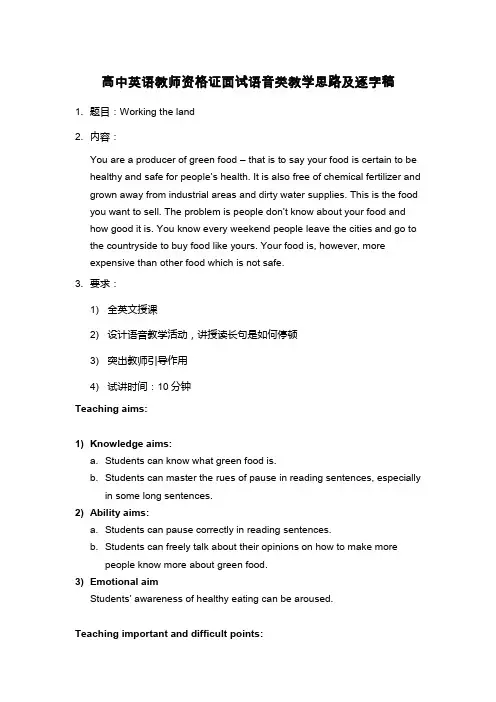
高中英语教师资格证面试语音类教学思路及逐字稿1. 题目:Working the land2. 内容:You are a producer of green food – that is to say your food is certain to be healthy and safe for people’s health. It is also free of chemical fertilizer and grown away from industrial areas and dirty water supplies. This is the food you want to sell. The problem is people don’t know about your food and how good it is. You know every weekend people leave the cities and go to the countryside to buy food like yours. Your food is, however, moreexpensive than other food which is not safe.3. 要求:1) 全英文授课2) 设计语音教学活动,讲授读长句是如何停顿3) 突出教师引导作用4) 试讲时间:10分钟Teaching aims:1) Knowledge aims:a. Students can know what green food is.b. Students can master the rues of pause in reading sentences, especiallyin some long sentences.2) Ability aims:a. Students can pause correctly in reading sentences.b. Students can freely talk about their opinions on how to make morepeople know more about green food.3) Emotional aimStudents’ awareness of healthy eating can be aroused.Teaching important and difficult points:Important points:Students can know what pause is and how to pause.Difficult points:How to make students understand what pause is.Teaching and learning methods:Task-based teaching method, situational teaching method, communicative approach.Teaching procedures:Step 1: warm-up and lead-in1) Warm-up: greet the students as usual.2) Lead-in: show some pictures of different kinds of food and ask students toclassify them into different groups: healthy food and junk food. Then lead in the topic: what is green food?Step 2: Preparation:1) Read the passage and answer the question:What is green food?2) Ask students to listen to the passage and take notes when it stops inreading sentences. Then discuss with partner and check all the pauses. 3) Guide students to discuss in groups about what pause is and when shouldwe pause in reading a sentence.4) Make a summary of the rules of pause.Step 3: PracticeGuide students to practice reading the passage by the rules of pause in it.Step 4: ProductionGroup discussion and make a report: four students in one group. Think about one question: how to make more people know about green food and buy it?Then each group chooses one representative to make a report. You should pay attention to the pause when making a report.Step 5: summary and homework1) Summary: ask students to summarize what we learned in this class.2) Homework: write a short passage to introduce green food and make arecord of your reading with pause and emotion.5 Blackboard designWorking the landWhat is green food? Some useful waysWhat is pause?When should we pause?逐字稿:Warm-up and lead-in (图片导入): class begins! Sit down, please. Good morning, class! How are you today? You are fine? Good. I’m fine, top. Thank you. First of all, let’s look at some pictur es on the screen. What are they? Yes, they are different kinds of food. So can you try to classify them into different categories? That is, make the into different kinds of foods, clear? Good, start here. Have you done? Ok, let’s check. John, you please. E m, picture 1, 2 and 4 are the same kind of food, like fried food and spicy food. We can call them junk food. Yeah, picture 3, 5, 6 are some meat, fruit and vegetables that can provide us with nutrition and energy, so we can make them into one category, that is, healthy food. You know, nowadays, people also call healthy food green food. Have you heard green food? What is green food? You can try to guess and imagine.Presentation:处理文本:O k, now let’s read the passage on your paper. And I believe that after r eading, you can see whether your guessing is right or not. So now let’s read it together and think about one question: what is green food>Have you finished? Ok, who can tell me the answer? Jessica, you please. Green food is a kind of healthy and safe food. So why is it healthy and safe?Can you find the answer from the passage? Great! Because it is free of chemical fertilizers (you know fertilizers, yes?) and grows away from industrial areas and dirty water supplies. Well done. The passage is not difficult for you to understand, yes? Good!感知语音现象:Now, I will read the passage for you and this tie, you should focus on my reading. Try to figure out where I stop when I’m reading. You can take notes if necessary. At last, tell me how many pauses in the passage. Clear? Great, let’s start here. Listen carefully. Ok, have you found out all the stops? No? ok, you can discuss with your partner now and check, and then me the finalanswer, OK? OK, I see that all of you have finished this task. Let’s check. Who wants to share with us? Jenny, you please. How many stops have you found? 14? Wow, you found out so many stops. Sit down, please. Any other different opinions? Oh, I heard 15. Catherine, what’s your opinion? 16? Ok, how many of you agree with Catherine? Put up your hands. Wow, about half of you think there are 16 stops in this passage. Well, I have to say that I also agree with you. There are altogether 16 stops n reading this passage. Actually, in English, we call these stops pause.发现发音规律:Now I am wondering where the pauses are and what the rules are of pausing. So now, please work in groups of four, try to discuss where should we pause and why should we pause, clear? Great. Let’s begin. Ok, time’s up. Have you found some findings yes, of c ourse. Well done. So let’s check your findings are right or not. Ok, group one, choose one representative to share with us. Ok, john,, you please. Well, in order to make it clear for us to know where the pauses are, you can try to read and pause at the right time. Clear? Go! Wow, your pronunciation and intonation are so good. It sounds like you are a native speaker. But you made a mistake when pausing. In the sentence “you know that every weekend people leave the cities and go to the countryside to buy food like yours”, there should be two pauses, the first pause is after that, and the second pause is before and. Clear?总结发音规律:S o what is sense group? I’ll explain it for you. A sense group is a language that shares the same meaning. Take sentence one as an example: you are a producer of green food… that is to say your food is certain to be healthy and safe for people’s health. In this sentence, every word has its own meaning and when they are combined together, they have a different meaning. You are a producer of green food. All the words are combined to form one meaning. When you pause at any word, it cannot convey the complete meaning of the sentence. Then we call it a sense group. Clear? Great!Practice:So up till now, we learned the rules of pause. Now, I’d like you to practice by using the rules we just summarized together. So I need you to practice reading the passage with correct pause. OK? Begin! Time’s up. Let’s see whether you can read correctly. Tom, you please. Have a try. Oh, you did a good job. But there is still one little mistake in pausing. We should pause after reading “thatis to say”. Or it’ll be too hard to read the whole sentences with no pause. Clear? Good. Sit down, please. Another one? Who? Ok, Helen! Wow, you made no mistake in readi ng, sit down please. Let’s clap our hands for her. All of you should practice more after class and it will be helpful for your spoken English!Production:N ow, let’s come back to this passage. As is mentioned in the passage that people don’t know about green food and how good it is, so what can we do to help more people know about it? Now, let’s do a group discussion and make a report: four students in one group. Think about one question: how to make more people know about green food and buy it? Then each group chooses one representative to make a report. You should pay attention to the pause when making a report. Are you clear? Great, let’s start here.O k, time’s up. Show us your results. Group one, who is therepresentative/reporter? Oh, lily, come to the front. Wow, you think that you can take more photos, make some introductions and even make some short movies to advertise it. Sounds great. How about group 2? Ok, Catherine, come here. Except what have been mentioned by group 1, you also give some good ways: like invite some specialists to make more explanation and to make more promotions to give people more chances to try more. You are such a problem solver. Ok, come back to your seat. Group 3 and group 4, you are all helpers. And your group members are all so creative. Great! Besides, maybe you can do from yourselves. You can get to know more about green food, then choose more green food to eat and keep a healthy diet in your daily life. Yea? Great!Summary:At last, let’s review what we learned in this class. Let’s do it together, ok? In this lesson, we learned what green food is, how to make more people know about green food, where to pause and how to pause.Homework:well, after class, I’d like you to write a short passage to introduce green food and make a record of your reading with pause and emotions. We will check it in the next class. Are you clear? Ok, great! That’s all for today’s class. Goodbye class. See you next time!语音考察方向:stop/pause 停顿;stress重音;liaison 连读;sense of group 意群;语调intonation;失去爆破:loss of plosive。
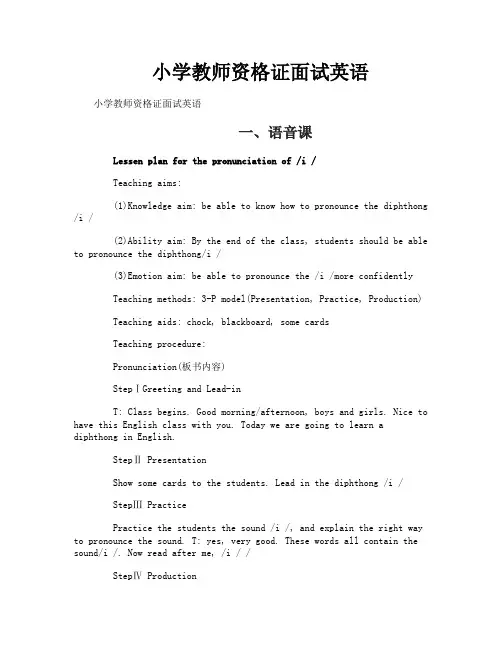
小学教师资格证面试英语小学教师资格证面试英语一、语音课Lessen plan for the pronunciation of /i /Teaching aims:(1)Knowledge aim: be able to know how to pronounce the diphthong /i /(2)Ability aim: By the end of the class, students should be able to pronounce the diphthong/i /(3)Emotion aim: be able to pronounce the /i /more confidentlyTeaching methods: 3-P model(Presentation, Practice, Production)Teaching aids: chock, blackboard, some cardsTeaching procedure:Pronunciation(板书内容)StepⅠGreeting and Lead-inT: Class begins. Good morning/afternoon, boys and girls. Nice to have this English class with you. Today we are going to learn a diphthong in English.StepⅡ PresentationShow some cards to the students. Lead in the diphthong /i /StepⅢ PracticePractice the students the sound /i /, and explain the right way to pronounce the sound. T: yes, very good. These words all contain the sound/i /. Now read after me, /i / /StepⅣ ProductionSound discrimination and tongue twisterStepⅤ SummarizeT: today, we have learned the sound /i /; remember the right way to pronounce this sound. It begins with the first sound /i/ and glide towards the second sound / /, you should practice more after class.StepⅥ HomeworkPractice the diphthong /i/ with your partner.考生在试讲过程中,一定要学会合理分配板书和讲授的时间。
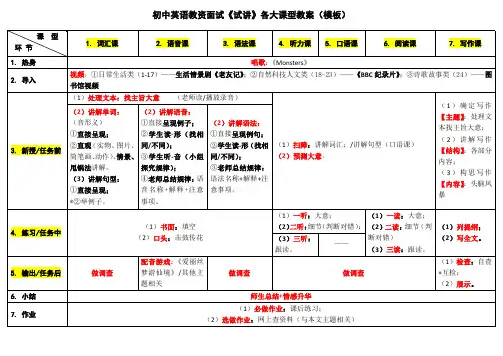
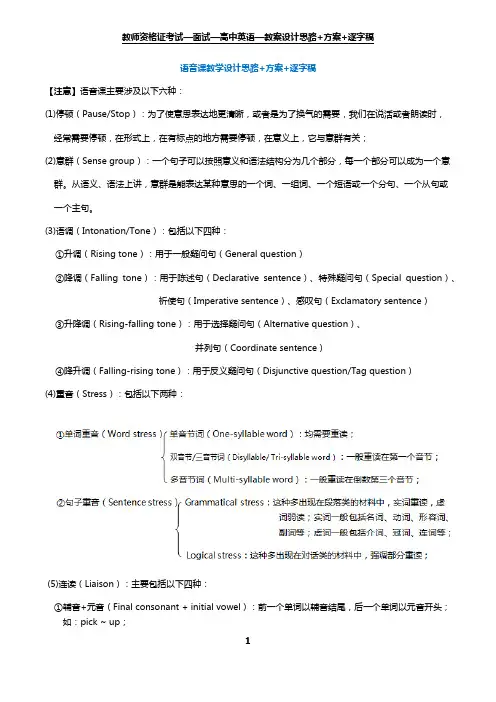
语音课教学设计思路+方案+逐字稿【注意】语音课主要涉及以下六种:(1)停顿(Pause/Stop):为了使意思表达地更清晰,或者是为了换气的需要,我们在说活或者朗读时,经常需要停顿,在形式上,在有标点的地方需要停顿,在意义上,它与意群有关;(2)意群(Sense group):一个句子可以按照意义和语法结构分为几个部分,每一个部分可以成为一个意群。
从语义、语法上讲,意群是能表达某种意思的一个词、一组词、一个短语或一个分句、一个从句或一个主句。
(3)语调(Intonation/Tone):包括以下四种:①升调(Rising tone):用于一般疑问句(General question)②降调(Falling tone):用于陈述句(Declarative sentence)、特殊疑问句(Special question)、祈使句(Imperative sentence)、感叹句(Exclamatory sentence)③升降调(Rising-falling tone):用于选择疑问句(Alternative question)、并列句(Coordinate sentence)④降升调(Falling-rising tone):用于反义疑问句(Disjunctive question/Tag question)(4)重音(Stress):包括以下两种:(5)连读(Liaison):主要包括以下四种:①辅音+元音(Final consonant + initial vowel):前一个单词以辅音结尾,后一个单词以元音开头;如:pick ~ up;②r/re+元音(r/re + initial vowel):前一个单词以r/re结尾,后一个单词以元音开头;如:for ~example;③元音+元音(Final vowel + initial vowel):前一个单词以元音结尾,后一个单词以元音开头;如:how ~ are you?④辅音+辅音(Final consonant + initial consonant):前一个单词以辅音结尾,后一个单词以辅音开头;后面的辅音实际上是半元音(semi-vowel);如:luck ~ you;(6)爆破(Plosive):主要包括以下四种:①失去爆破(Loss of plosive):当2个爆破音相连时,第一个“引而不发”,第二个爆破;爆破音包括:/b/ /p/ /d/ /t/ /g/ /k/ ;如:doctor;②不完全爆破(Incomplete plosive):当爆破音后面跟有摩擦音(/f/ /v/ /θ/ /ð/ /s/ /z/ /ʃ/ /ʒ//h/)、破擦音(/tʃ/ /dʒ/)时,前面的爆破音只做部分爆破;如:good friends;③/t/ 或 /d/ + /m/ 或 /n/ 型:如:good morning;④/t/ 或 /d/ + /l/ 型:handle;【设计思路】语音课,我们采用3P模式,即presentation, practice以及production;各个环节可以设计的活动如下:【教案】Teaching PlanTeaching Aims:Knowledge aims:(1)Students can know the meaning of …(语音现象)in English language studying.(2)Students can learn …(材料内容)Ability aims:(根据语音现象选择)①停顿/意群:Students can pause correctly according to the sense group in reading sentences.②语调:Students can recognize different intonations of different sentences, such as declarative sentence, general question.③重读:Students can understand the intention of speaker and the changes of meaning through the changes of stress.④连读:Students can read the sentences more fluently by using the knowledge of liaison.⑤爆破:Students can read English sentences more fluently by using the knowledge of loss of plosive.Emotional aims: (以下内容选一/二即可)(1)Students can get more interests and confidence in learning English.(2)Students will be willing to apply their English into daily use.(3)Students can get the awareness of cooperation with others.Teaching Key & Difficult Points:Teaching key point:Students can know what …(语音现象)is and how to use it.Teaching difficult point:How to make students understand what …(语音现象) is.Teaching Procedures:Step 1 Warming up1.Greetings.2.Lead-in: (以下导入方式选其一即可)①Review the knowledge that we learned before/in the last class with the students: …②Check students’ homework that I assigned in the last class: …③Share a story/saying/experience with students: …④Show students some pictures about … and ask them to think about the following questions:/ Play a short video to the students and ask them to think about the following questions during watching:Q1: …Q2: …⑤Free talk: ask students to discuss the following question and then invite some of them to share their answers:Q: …⑥Tongue twister: read one/some tongue twisters twice for the students and ask them which time is better and why.Tongue twisters: How many cookies could a good cook cook if a good cook could cook cookies?Can you can a can as a canner can can a can?(读的时候,第一遍可以不是很好,第二遍要又快又准,并且要用到材料中所涉及的语音现象;提供的绕口令要与语音现象有关;)Step 2 Presentation(1)Deal with the material: (以下方式取其一即可)①Play the tape once or twice, ask students to get the main idea of it or just ask them one or two questions:Q1: …Q2: …(以上是将材料作为听力材料所设计的活动;若文章要求朗读文章,此步骤可设计成教师朗读;若材料比较简单,可以只听一遍)②Read the passage once or twice, ask students to get the main idea of it or just ask them one or two questions:Q1: …Q2: …(以上是将材料作为阅读材料所设计的活动;若文章要求朗读文章,此步骤可设计成教师朗读;若材料比较简单,可以只读一遍)(2)根据语音现象从以下中选择:①停顿/意群:Read the passage for the students, then ask them “how many stops are there in my reading?”②语调:Read the passage for the students and read some new sentences twice, then ask them “what’s the difference of these two times?”③重音:Read the passage for the students and read some new sentences twice, then ask them “what’s the difference of these two times?”④连读:Read the passage for the students and read some new sentences twice, then ask them “which time is better and why?”⑤爆破:Read the passage for the students and read some new sentences twice, then ask them “what’s the difference of these two times?”(3)Make a summary about the rules of …(语音现象)Step 3 PracticeAsk the students to read the passage with the rules of …(语音现象), then invite some of them to share and give evaluation.Step 4 ProductionPlay a dubbing game: play a short video and then ask students to play a dubbing game.Step 5 Summary and HomeworkSummary: ask a student/lead the students to summarize the content of this lesson.(总结环节可以是老师自己总结,让同学总结,老师和同学一起总结三种方式,一般使用后两种方式比较好)Homework: ask students to write a short passage about … and make a record of their reading with the rules of …(语音现象) and emotion.Blackboard design:【试讲逐字稿】[自我介绍]:Good morning/afternoon, dear judges, I’m No.X candidate applying for high school English teacher. (有的地方不让说姓名,只能说号码,但有的地方规定要说姓名,进入面试室时,有人会给你看一下注意事项,所以请一定看清,否则说错了会视为作弊,取消资格的)(上面这一句是在敲门得到允许进去后,所做的自我介绍,或者是向考官问好,一般考官会回应说:good morning/afternoon,之后你需要走到讲台上,进行结构化答题,回答结束后,考官会说请开始你的试讲)分割线—下面是真正的试讲逐字稿Today my topic is …, now I’ll start my class.[Greetings]:Class begins, sit down please. Good morning/afternoon, boys and girls, welcome to my class. How are you guys today? Great? Not bad? Glad to hear that. Me? Oh I’m pretty good, thanks for your asking. So are you ready for our class? Ok, good.[Lead-in]:以下方式选其一即可(建议在此步骤中,若能与文章标题联系起来的时候,可以书写板书:具体的标题,若文章没有标题,可以找机会一边说:today we’re going to have a reading class, 一边书写板书:reading)①Before our class, boys and girls, let’s have a quick review about what we learned in the last class. Do you still remember it? Great, you all remember it. Yes, we learned about …. Now as for today we are going to learn more about it/we are going to learn another grammar.②Before our class, boys and girls, do you still remember the task that I assigned for you in the last class? Yes, it is … Ok, so how many of you have prepared it? Show me your hands. Ok Anna, please. (此处停顿几秒,假装Anna在回答)Excellent, I can see you did it with your heart. Now as for today, we are going to learn …/we are going to talk more about …③-1.Before our class, boys and girls, I’d like to share a story with you. After the story, you need to tell me …(此处可以出一个问题)So please listen to me carefully. …(讲故事)So who wants to share your answers with us? Anna, please. …(Anna的回答)Very good, sit down, please. Now as for today, we are going to learn …/we are going to talk more about …③-2.Before our class, boys and girls, I have s sentence for you, please listen to me carefully and please try to guess its meaning …(此处讲一个名人名言)So who wants to share your answers with us? Anna, please. …(Anna的回答)Very good, sit down, please. Now as for today, we are going to learn …/we are going to talk more about …③-3.Before our class, boys and girls, I’d like to share one experience of mine with you …(讲经历)So how about you? Do you have any unforgettable experience? Anna, please share with us. …(Anna的回答)Very good, sit down, please. Now as for today, we are going tolearn …/we are going to talk more about …④Before our class, boys and girls, let’s watch a short video/some pictures, and you need to think about the following questions: Q1: … and Q2: … Are you clear? Ok, great, let’s start here.(观看视频/图片,停顿几秒)Well you have enjoyed the video/the pictures, have you got the answers? Anna, you please. Oh you think … Yes, great, sit down please. How about question 2? Peter, please have a try. You think … I agree with you, sit down please. Now as for today, we are going to learn …/we are going to talk more about …⑤Before our class, boys and girls, I’d like to ask you a question: … Anna, please have a try. Yeah, …(Anna的回答)Wonderful, thank you, sit down please. And? Peter, please. Great, …(Peter的回答)Now as for today, we are going to learn …/we are going to talk more about …⑥Before our class, boys and girls, I have a tongue twister for you. Please listen to me carefully. …(绕口令)and please think about one question: why do you think tongue twister can be spoken so smoothly and quickly? Uh huh, yes, we can speak two or three words in a way of connecting. Good point, and in English, we call it liaison. Now as for today, we are going to learn more about it. (此处是以连读为例)[Presentation]:(1)以下方式选其一即可:①Now let’s listen to the tape. Please listen carefully and try to catch the main idea of it /try to think about the following one/two questions:Q1: …Q2: …Are you clear? Start here.(停顿几秒)It’s over, so have you got the main idea of it? Good, it’s … Very good.②Now let’s take out our paper and look at the reading passage. Please read it carefully to catch the main idea of it/to think about the following one/two questions:Q1: …Q2: …Are you clear? Start here.(停顿几秒)It’s over, so have you got the main idea of it? Good, it’s … Very good.(2) 以下方式选其一即可:①停顿/意群:Ok, now guys, I’ll read the passage for you again, and this time, please focus on my reading, and try to figure out where I stop when I’m reading. You can make notes if necessary, and at last, you need to tell me how many stops in the passage. …(教师朗读文章)Ok, how many stops do you found? Lily you please. …(Lily的回答)Good, sit down please. Do you agree with her? Yes? Very good.②语调:Ok, now guys, I’ll read the passage for you again, and this time, please focus onmy reading, and try to figure out some differences among some sentences. …(教师朗读文章,若没有要求,可以省略)Now it’s time to learn something new. Let’s look at a new sentences. I’ll read it twice, then please tell me the difference of these two times, clear? Ok, …(读两遍)Ok, can you tell me the difference of them? Please discuss it with your partner, then share with us, ok? Good, start.(停顿几秒)Who wants to share? Ok, Lily you please. You used different tones. Good, you got the point, sit down, please.③重音:Ok, now guys, I’ll read the passage for you again, and this time, please focus onmy reading, and try to figure out some differences among some sentences. …(教师朗读文章,若没有要求,可以省略)Now it’s time to learn something new. Let’s look at a new sentences. I’ll read it twice, then please tell me the difference of these two times, clear? Ok, …(读两遍)Ok, can you tell me the difference of them? Please discuss it with your partner, then share with us, ok? Good, start.(停顿几秒)Who wants to share? Ok, Lily you please. You emphasized different words each time. Good, you got the point, sit down, please.④连读:Ok, now guys, I’ll read the passage for you again, and this time, please focus onmy reading, and try to figure out some differences among some sentences. …(教师朗读文章,若没有要求,可以省略)Now it’s time to learn something new. Let’s look at a new sentences. I’ll read it twice, then please tell me which time is better, clear? Ok, …(读两遍)Which one is better? The second time? Ok, can you tell me why the second time is better? Please discuss it with yourpartner, then share with us, ok? Good, start.(停顿几秒)Who wants to share? Ok, Lily you please. Because you speak “…” and “…” in a way of connecting. Good, you got the point, sit down, please.⑤失爆:Ok, now guys, I’ll read the passage for you again, and this time, please focus onmy reading, and try to figure out some differences among some sentences. …(教师朗读文章,若没有要求,可以省略)Now it’s time to learn something new. Let’s look at a new sentences. I’ll read it twice, then please tell me the difference of these two times, clear? Ok, …(读两遍)Ok,can you tell me the difference of them? Please discuss it with your partner, then share with us, ok? Good, start.(停顿几秒)Who wants to share? Ok, Lily you please. You didn’t speak the letter “…” in the word of “…” in the second time. Good, you got the point, sit down, please.(3) 以下方式选其一即可:①停顿/意群:Actually in English, we call it “pause”(此时可以书写板书:what is pause?). Now I am wondering what the rules of pause are? Now please work in groups of four to discuss about it. You will have 5 minutes, clear? Ok, start.(停顿几秒,此时可以书写板书:when should we use pause?)Ok, time’s up. So have you found the rules? Well your group think that we should pause when we meet “and ”, “but”, “however”, “that”, “which” etc, and your group think that we should pause when we meet phrases and clauses. Very good. Let’s summarize the rules together. Actually we can say that we should pause in sense groups. So what is sense groups? A sense group is a language group that share the same meaning. That is to say, in a sentence, every word has its own meaning, and when they are combined together, they have a different meaning. When you pause at any word, it cannot convey the complete meaning of the sentence. Then we call it a sense group, clear? Great.②语调:Actually in English, we call it “intonation” or “tone”(此时可以书写板书:what is intonation?). Now I am wondering what the rules of intonation are? Now please work in groups of four to discuss about it. You will have 5 minutes, clear? Ok, start.(停顿几秒, 此时可以书写板书:when should we use intonation?)Ok, time’s up. So have you found the rules? Well, let’s summarize it together. We use rising tone in general questions, falling tone in declarative sentences, special questions, imperative sentences and exclamatory sentences. We use rising-falling tone in alternative questions, and coordinate sentences. For example, in an alternative question, there are two parts, we use rising tone for the first part, and falling tone for the second part. And we use falling-rising tone in disjunctive questions. For example, in an disjunctive question, there are two parts, we use falling tone for the first part, and rising tone for the second part. Clear? Great.③重音-1:单词重音:Actually in English, we call it “ word stress”(此时可以书写板书:what is word stress?). Now I am wondering what the rules of it are? Now please work in groups offour to discuss about it. You will have 5 minutes, clear? Ok, start.(停顿几秒, 此时可以书写板书:when should we use word stress?)Ok, time’s up. So have you found the rules? Well, let’s summarize it together. For one-syllable words, we need to stress them, for disyllable or try-syllable words, normally we need to stress on the first syllable, and for multi-syllable words, we need to stress on the antepenultimate syllable. Clear? Great.③重音-2:句子重读-Grammatical stress:Actually in English, we call it “grammatical stress”(此时可以书写板书:what is grammatical stress?). Now I am wondering what the rules of it are? Now please work in groups of four to discuss about it. You will have 5 minutes, clear? Ok, start.(停顿几秒, 此时可以书写板书:when should we use grammatical stress?)Ok, time’s up. So have you found the rules? Well, let’s summarize it together. Normally, we stress the notional words not the functional words. And notional words include nouns, verbs, adjectives, adverbs, etc,. and functional words include prepositions, article, adjunction, interjection, etc,. Clear? Great.③重音-3:句子重读-Logical stress:Actually in English, we call it “logical stress”(此时可以书写板书:what is logical stress?). Now I am wondering what the rules of it are? Now please work in groups of four to discuss about it. You will have 5 minutes, clear? Ok, start.(停顿几秒, 此时可以书写板书:when should we use logical stress?)Ok, time’s up. So have you found the rules? Well, let’s summarize it together. Normally, we highlight or stress the information that the speaker or someone wants to know. Clear? Great.④连读:Actually in English, we call it “liaison”(此时可以书写板书:what is liaison?). NowI am wondering what the rules of it are? Now please work in groups of four to discuss about it. You will have 5 minutes, clear? Ok, start.(停顿几秒, 此时可以书写板书:when should we use liaison?)Ok, time’s up. So have you found the rules? Well, let’s summarize it together. Normally, we can say the structure is: Final consonant + initial vowel, which means the first word is ended with a consonant and the second one is beginning with a vowel, such as pick ~ up./Final letter r/re + initial vowel, which means the first word is ended with the letter of r/re, and the second one is beginning with a vowel, such as for ~ example. /Final vowel + initial vowel, which means the first word is ended with a vowel and the second one is beginning with a vowel, such as how ~ are you? /Final consonant + initial consonant, which means the first word is ended with a consonant and the second one is beginning with a consonant, such as luck ~ you.(一般材料中只会涉及一种形式,请根据材料选择相应的形式) Clear? Great.⑤爆破:Actually in English, we call it “loss of plosive”(此时可以书写板书:what is loss of plosive?). Now I am wondering what the rules of it are? Now please work in groups of four to discuss about it. You will have 5 minutes, clear? Ok, start.(停顿几秒, 此时可以书写板书:when should we use loss of plosive?)Ok, time’s up. So have you found the rules? Well, let’s summarize it together. There are six plosives: /b/ /p/ /d/ /t/ /g/ /k/, when any two of them meet, for the first one, you just give the shape of the mouth, do not need to give any sound of it. Such教师资格证考试—面试—高中英语—教案设计思路+方案+逐字稿as: doctor. /There are six plosives: /b/ /p/ /d/ /t/ /g/ /k/, and when any of them is followed with a fricative (/f/ /v/ /θ/ /ð/ /s/ /z/ /ʃ/ /ʒ/ /h/) or affricative (/tʃ/ /dʒ/), for the plosive, you just give a slight sound. Such as: good friend. /When /t/ or /d/ is followed with /m/ or /n/ or /l/, for /t/ or/d/, you just give the shape of the mouth, do not need to give any sound of it. Such as: good morning. (一般材料中只会涉及一种形式,请根据材料选择相应的形式) Clear? Great.[Practice]:Practice makes perfect. So let’s do some exercises. Please read the passage again. This time, you need to use the rules of …(语音现象)and then we’ll invite some of you to share with us, clear? Ok, start here.(停顿几秒)Now time’s up, who want to have a try? Lucy you please. (不需真正回答,只需停顿几秒,然后直接点评即可)Good, you did a good job, but there’s still some little mistakes. …(改正)Clear? Good, sit down please. Another one? Peter, please have a try.(不需真正回答,只需停顿几秒,然后直接点评即可)Well done, you made no mistake, sit down, please.[Production]:Since we mastered the knowledge well, let’s play a dubbing game, we will watch a movie, for the first time, listen to it carefully, and the second time, it’ll be silent, you need to choose your own character and try to make the scene as interesting as you can, please try to use the rules of …(语音现象)that we just learned, then we’ll have some students to share, clear? Good, start.(停顿几秒)Time’s up. Group one, please share your performance with us. (不需真正回答,只需停顿几秒,然后直接点评即可)Excellent, you all give a wonderful performance. I’m very proud of your progress and smart ideas.[Summary and homework]:How time flies! It’s time to make a summary. Let’s do it together. Today we havelearned … Yes, very good, and the rules of it are …. Ok good, we all did a good job in this class.(老师带领大家一起回答时,当说到重点的时候,要有所停顿,因为我们需要做的是引导学生回答,而不是我们自己回答)Well, after class, I’d like you to write a short passage about … and make a record of your reading with what we learned today. Are you clear? Ok, great. That’s all for today’s class. Goodbye class, see you next time.[结尾]:That’s all for my presentation, thank you![接下来就是答辩]11。
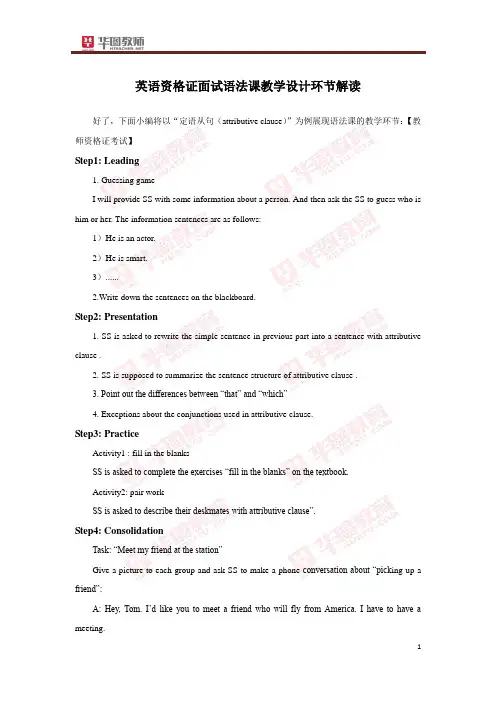
英语资格证面试语法课教学设计环节解读好了,下面小编将以“定语从句(attributive clause)”为例展现语法课的教学环节:【教师资格证考试】Step1: Leading1. Guessing gameI will provide SS with some information about a person. And then ask the SS to guess who is him or her. The information sentences are as follows:1)He is an actor.2)He is smart.3)......2.Write down the sentences on the blackboard.Step2: Presentation1. SS is asked to rewrite the simple sentence in previous part into a sentence with attributive clause .2. SS is supposed to summarize the sentence structure of attributive clause .3. Point out the differences between “that” and “which”4. Exceptions about the conjunctions used in attributive clause.Step3: PracticeActivity1 : fill in the blanksSS is asked to complete the exercises “fill in the blanks” on the textbook.Activity2: pair workSS is asked to describe their deskmates with attributive clause”.Step4: ConsolidationTask: “Meet my friend at the station”Give a picture to each group and ask SS to make a phone-conversation about “pick ing up a friend”:A: Hey, Tom. I’d like you to meet a friend who will fly from America. I have to have a meeting.B: What’s she like?A: She is a young lady who is tall and thin. She has yellow hair that is long and straight. Step5: SummarySS summarize the grammatical points they have learned in this lesson and the differences between two conjunctions;Teacher makes necessary supplements.SS will enhanced the ability of using attributive clause in practical and understand the importance of cross culture communication.Step6: HomeworkIntroduce a holidayThe friend you have picked up is interested in the traditional Chinese festivals. So i will ask SS to introduce some festivals to him using the attributive clause. And report their works tomorrow。
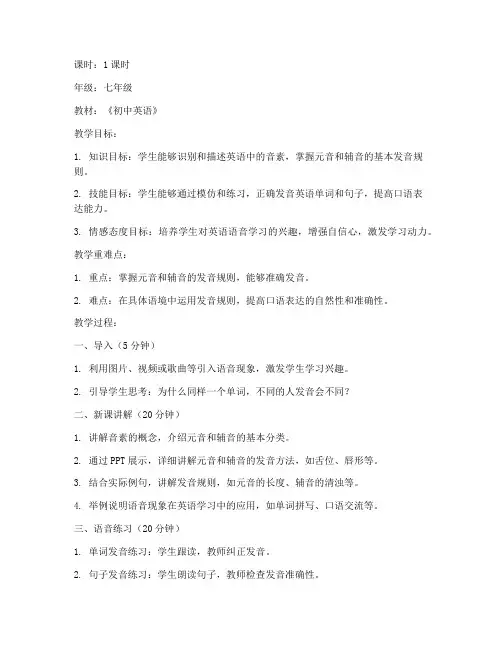
课时:1课时年级:七年级教材:《初中英语》教学目标:1. 知识目标:学生能够识别和描述英语中的音素,掌握元音和辅音的基本发音规则。
2. 技能目标:学生能够通过模仿和练习,正确发音英语单词和句子,提高口语表达能力。
3. 情感态度目标:培养学生对英语语音学习的兴趣,增强自信心,激发学习动力。
教学重难点:1. 重点:掌握元音和辅音的发音规则,能够准确发音。
2. 难点:在具体语境中运用发音规则,提高口语表达的自然性和准确性。
教学过程:一、导入(5分钟)1. 利用图片、视频或歌曲等引入语音现象,激发学生学习兴趣。
2. 引导学生思考:为什么同样一个单词,不同的人发音会不同?二、新课讲解(20分钟)1. 讲解音素的概念,介绍元音和辅音的基本分类。
2. 通过PPT展示,详细讲解元音和辅音的发音方法,如舌位、唇形等。
3. 结合实际例句,讲解发音规则,如元音的长度、辅音的清浊等。
4. 举例说明语音现象在英语学习中的应用,如单词拼写、口语交流等。
三、语音练习(20分钟)1. 单词发音练习:学生跟读,教师纠正发音。
2. 句子发音练习:学生朗读句子,教师检查发音准确性。
3. 小组活动:学生分组,互相练习发音,教师巡回指导。
4. 语音游戏:设计趣味性语音游戏,让学生在游戏中提高发音能力。
四、课堂小结(5分钟)1. 回顾本节课所学内容,强调重点和难点。
2. 学生分享学习心得,教师点评。
五、布置作业(5分钟)1. 学生自选单词或句子,进行语音练习。
2. 家长协助,监督学生完成语音练习。
教学评价:1. 课堂参与度:观察学生在课堂上的表现,如发言、练习等。
2. 发音准确性:检查学生在课堂练习和作业中的发音准确性。
3. 学习效果:通过语音测试,评估学生对语音知识的掌握程度。
教学反思:1. 教师在讲解过程中,要注意结合实际例句,让学生更好地理解发音规则。
2. 在语音练习环节,要关注每个学生的发音情况,及时纠正错误。
3. 鼓励学生积极参与课堂活动,提高他们的学习兴趣和自信心。
初中英语教学法面试语音课逐字稿本文档是一份面试语音课的逐字稿,目的是为了展示初中英语教学法的能力和技巧。
以下是面试课的具体内容和教学方法。
课堂介绍本节课重点教授英语的语音知识,主要包括发音、音标和语调。
课程时长约为40分钟。
课程目标- 培养学生正确的英语发音惯- 研究基础音标和常见发音规则- 提高学生的听力和口语能力教学流程1. 课堂开场:用简单的英语问候学生,引起学生的兴趣和注意。
2. 导入活动:播放一段短语音材料,让学生跟读。
通过听和模仿提高学生的发音准确度。
3. 音标介绍:使用课件或黑板展示基础音标,逐个介绍其发音规则和示范。
让学生跟读音标,并纠正他们的发音错误。
4. 练活动:设置一些发音练,如搭配练、语调练等。
鼓励学生积极参与,建立自信心。
5. 板书总结:将学过的音标和发音规则整理在黑板上,供学生复和记忆。
6. 结束活动:与学生互动,进行简单的问答或小游戏,巩固所学内容并营造良好的课堂氛围。
教学策略- 融合任务型教学法和互动式教学法,使学生在实践中掌握和运用所学知识。
- 使用多媒体资源和示范,帮助学生更好地理解和模仿正确发音。
- 培养积极的研究氛围,让学生愿意参与课堂活动,提高研究效果。
教学评估- 通过观察学生的发音和参与度来评估其研究成果。
- 可以设置一些听力和口语练,检验学生对所学知识的掌握情况。
参考资料- 外语教学与研究出版社(Foreign Language Teaching and Research Press)出版的初中英语教材和教学指南。
以上是初中英语教学法面试语音课的逐字稿。
通过本节课的教学内容和方法,我们可以帮助学生掌握正确的发音并提高听力和口语能力。
希望能获得面试机会,以展示更多的教学能力和经验。
谢谢!。
学科知识与教学能力笔记(英语)一、语音考点 (一)元音Vowels 考点1:元音的舌位图我们先来看看英语单元音的舌位图(P70)。
图的左方为口腔的前部,右方为其后部。
竖线把舌头分成前中后三个部分;横线表示牙床的开合程度,图中的圆点表示元音音素发音时舌头抬得最高的那一部分在口腔中的位置。
单元音可按发音时舌头前、中、后哪一部分抬得最高而分成三类:前元音,中元音,后元音(back vowels )。
元音一般从四个方面进行描述:舌位(high, mid, low ),舌头最高部位的位置(front, central, back ),长度(long, short )或紧张度(tense, lax ),唇的开口度(rounded, unrounded )音标描述汇总:[i:] h igh front tense unrounded vowel [І] hi gh front lax unrounded vowel [u:] high back tense rounded vowel [ʊ]即[u] high back lax rounded vowel [З:]或[ə:] central tense unrounded vowel [ə] central lax unrounded vowel[e] mid-high front lax unroundedvowel[æ] low front lax unrounded vowel[Λ] mid-low back lax unrounded vowel [ɔ:] mid-low back tense rounded vowel [ɒ] low back lax rounded vowel[ɑ:] low back tense unrounded vowel考点2:专有名词基本元音Cardinal Vowels纯元音Pure Vowels/单元音Monophthong Vowels滑元音Vowels glides:There is an audible change of quality. ——If a single movement of the tongue is involved, the glides are called双元音Diphthongs如:[eI] from mid-low front to high front[aI] [ɔI] [əʊ] [aʊ] [Iə] [eə] [ʊə] 略A double movement produces 三元音Triphthong例如:tower中[aʊə](二)辅音ConsonantsConsonants are sounds produced by constricting or obstructingthe vocal tract at some place to divert, impede or completely shutoff the flow of air in the oral cavity.Vowels元音: produced without such obstruction so no turbulence or a total stopping of the air can be perceived.区别:the distinction between vowels and consonants lies in the obstruction of airstream.阻塞气流。
高中英语教师资格证面试--语音教学(读音规则)实用版1、重音(Stress):指的是读音节的时候的发声程度。
(Stress refer to the degree of force used in producing a syllable.)分为单词重音和句子重音。
单词重音:(stress at word level)有重音的单词一般至少有两个以上音节。
(Stress only applies to words withat least two syllables)句子重音:(stress at sentence level)结构重音(structural stress):句与句之间的对比产生的某一个单词重音的变化或某一个一般不重读的单词的重读,(The comparison between sentences result in the structural stress).如ThirtTEEN girls and thirty boys 中的TEEN重读。
强调重音(contrastive stress) :指纯粹出于交际需要对句中的任意部分进行强调,句中的任意音节都可能成为重读音节。
(We can stress any part of a sentence for the purpose of communication)语法重音(grammatical stress ):约定俗成的语法成分功能决定的重音,如重读实词,轻读虚词等。
(The prescribed grammatical function would contribute to the stress of a sentence)2、语调(Intonation):说话的腔调。
(The intonation is the way that your voice rises and falls as you speak.)英语基本语调:升调(rising intonation 或者rising tone)、降调(fallingintonation 或者falling tone).升调用于一般疑问句(general question),选择疑问句的前一部分(the former part of the alternative sentence),第一人称并列句(the first-havecompound sentence)中1、一般疑问句:Is that your pen?↗2、选择疑问句的前一部分:Is he your father ↗or your uncle↘?3、第一人称并列句:I have a pen↗, a pencil↗, and an easer ↘in mypencil-box.降调用于陈述句(declarative sentence)、祈使句(imperative sentence)、特殊疑问句(special question)和感叹句(exclamatory sentence)。
高中英语《语音-升降调》一、考题回顾二、考题解析高中英语《语音-升降调》主要教学过程及板书设计教学过程Step 1: Warming upShow some tongue twisters on the screen and ask students to read and practice them. They can make competitions with their desk mates.Can you can a can as a canner can can a can?Whether the weather be fine or whether the weather be not. Whether the weather be cold or whether the weather be hot. We'll weather the weather whether we like it or not.Step 2: Presentation1. Listen to the tape and later I will invite some students to tell us what he/she has heard from the tape and how many people they can find during the listening.2. Teacher read the same material as the listening without rising tone and falling tone.Students should compare these two listening and talk about the difference between the teacher’s reading and the tape.3. Guide students to find out the rising tone and falling tone in this conversation.4. Show the new knowledge:(1) General question---rising tone Would you…? May I…? Are you…?(2) Special question---fallin g tone What…? Where…? How…?(3) Declarative sentence---falling tone I can…? Go ahead please. See you ….Step 3: Practice1. Read the conversation loudly and use the correct tone in 3minutes.2. Practice this conversation with their partner in five minutes.Step 4: Production1. Invite some of them to perform this dialogue in front of the class.2. Write more sentences in groups in the table. They just have 3 minutes; the group which finishes fast in both quantity and quality can get some small gifts (post card, book marks).Step 5: Summary & Homework1. Summarize with students together that we’ve learnt a pronunciation lesson about rising and falling tones.2. (1) Listen to the tape and read the rest of the context with correct answer.(2)Watch a movie which they like best and write some rising and falling tones sentences on their note book (at least ten).板书设计答辩题目解析1.你这节课的重点是什么?【参考答案】本节课的重点是英语中升降调的学习。
解析:Teaching aims:Knowledge aims:Students are able to understand the content of the passage.Students can know some basic information of liaison.Ability aim:Students can use different basic reading strategies like analyzing,grasping details correctly in their reading process.After this lesson,students can use the target knowledge into their daily life.Emotional aim:Students will be more willing to get involved in class activities and boost their interest in learning English.Key and difficult point:Key Point:master the rules of liaison.Difficult Point:use the target knowledge to their daily life correctly.Teaching procedures:Step1:Warming-up1.Greeting:talk about weather2.Sing a song“hand in hand”,and ask students“when you hear this song,which event comes to your mind?”Step2:Presentation1.Ask students to open the book and the teacher reads the passage and ask students the main idea of the passage.2.Read this article for students,and read the first sentence for them twice.Then ask them to discuss the differences between these two times and write down the sentence on the blackboard.①Fu Mingxia first stood on top of the10-metre diving platform at the age of nine.②At12years old she won a Guinness Record when....3.Invite students to share their ideas then make a conclusion of liaison,structure: consonant+vowelStep3:PracticeAsk students read the article again then invite Ss come to the front and read for others.Step4:Production4of a group,show students Shelley’s poem,ode to the west wind.Give them5minutes to practise this poem,then invite some students read the poem for us,choose the best one.Step5:Summary and HomeworkSummary:ask a student to conclude the content of the lesson and summarize with the whole class.Homework:Try to surf on the Internet and find more rules of liaison.Blackboard design:略。
英语资格证面试语音课教学设计环节解读
2017年已近半,对于将来想要从事教师这个职业的小伙伴来说,这几个月份有着不同的意义,因为作为老师这个职业的敲门砖——教师资格证的考试在这几个月中如火如荼的展开。
紧张的笔试已经结束,那么面试又应如何准备?小伙伴们是不是有些无从下手?大家先不要着急,作为你们的老朋友,老师正在积极的为大家备考助力。
那么今天我们就先聊一聊英语面试语音课的相关环节。
【教师资格证考试】
在讲解具体的环节之前,我们先了解一下小学英语语音课的要求:语音教学是语言教学的重要内容之一,主要目的是通过教学使学生在听和说两个方面有所提高。
在英语教学起始阶段,语音教学主要应通过模仿来进行,教师应提供大量听音、模仿和实践的机会,帮助学生养成良好的发音习惯。
英语有不同的口音,如:英国口音、美国口音等。
教学中,应让学生在基本掌握一种口音的基础上,适当接触不同的口音,为他们发展交际能力打下基础。
了解完语音课的要求之后,我们来梳理一下教材,看一看教材中的哪一部分是要设计成语音课的。
教师资格证面试试题所选自的课文多出自人民教育出版社的教材。
熟悉人教版小学英语教材的同学都知道每一个单元所包括的版块有:Let’ try;Let’s talk;Let’s learn;Role-play;Let’s spell;Read and write等等。
当给出的版块是Let’s spell时,我们要设计的就是语音课了,如下图所示:
义务教育英语课标要求学生具备听说读写四个方面的能力,英语作为一门语言科学,尝到了传统应试教育中“哑巴英语”的众多弊端之后,在素质教育的今天更强调学生能否在日常生活中用英语表达自己,能否听得懂、说的顺,能否学以致用,也就是说更加注重听、说技能的培养。
在技能教学中,我们最常用的方式就是“导入、新授、练习、巩固、小结、作业”的模式。
那么,我们具体要根据什么来设计课堂环节呢?根据义务教育阶段的英语课程标准,可以得出,在导入及新授环节,我们主要是以学习和掌握相关语音为目的来设计教学活动;在练习巩固阶段,要综合练习所学新知识,尤其在巩固的阶段,设计的教学活动应以口头表达、角色扮演、小组讨论等任务的形式来展开,多多的联系实际。
【教师资格证考试】那么具体应该如何操作呢?下面我们就以所示课文为例,展现语音课的教学环节:Step1: Leading
Good morning, Boys and girls! Today is a sunny day, right? My friend Lucy had a trip yesterday. Do you want to know where she went? Yes, I want to know it, too. Now, let’s watch a video.
Who can guess where it is? Lily, please! You said it’s in a farm. Do you all agree with her? Yes, you really did a good job! Lucy went to the farm. Do you want to know what she saw in the farm?
Step2: Presentation
Wow! Boy and girls, we are in the farm now. Is it beautiful? Yes, the farm is big and beautiful! Let’s find our good friend Lucy, ok? Wher e is Lucy? Oh, she is over there. What is she doing? Let’s go to see. Who can tell us what she is doing? Sam, please! You said she is looking a beautiful flower, right? Yes, it’s a flower. Everybody, read after me, flower, flower. Ok, you please. Flower, [aʊ],[aʊ], try again, very good!
Let’s follow Lucy to look around. Wow! What can you see? It’s a cow! Cow, cow, cow. [aʊ],[aʊ]. Cow, cow, cow. Is the cow big? Yes, the cow is very big.
Step3: Practice
Activity: Now let’s do “listen, circle and say”. I w ill read and you circle the different one. Got it? Yes! Are you ready? The second one: how, flower, window. The third one: now, snowy, slow. Did you finish? Fantastic! Who wants to show your answer? You, please. The second one is window. Excellent!
Who ca n answer the third one? Ok, you please! You chooses snowy? I’ m sorry. Would you like to try again? Good!Listen carefully! Now, snowy, slow. Which one is different from others? Great! Everybody, slow, [əʊ], [əʊ], slow. The others are [aʊ],[aʊ], now, snowy.
Step4: Consolidation
Let’s do the “listen, write and say”. The faster, the winner. Clear? Well done! Are you ready? Yes! I see a yellow flower. Slow done. How about tomorrow? Who wants to try? Wow, you are so fast. The first sentence is? Wonderful! I see a yellow flower. It’s flower. Give your group two stars.
Step5: Summary
Boys and girls, what have you learnt today? Yes, we learnt the pronunciation of “ow”. And, we learnt many words with “ow” and their difference. Good job! Today, we see what there are on the farm from our friend Lucy. We have a happy time. Right? Yes! I hope we can always learn from Lucy. Do you also think so?
Step6: Homework
We learnt so many words with “ow”, today’s homework is to read the words we learnt today with your partners. Ar e you clear? Yes! Ok, Today’s class is over. Bye-bye!See you tomorrow!
【教师资格证考试】。